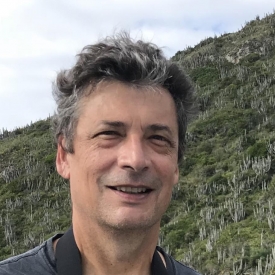Biological invasions - the establishment of species beyond their historical range - are a major force of ecological and evolutionary change. Our lab aims to understand the patterns, processes, and consequences of invasions in marine ecosystems on local to global scales. We have laboratories and staff on both coasts of North America, on Chesapeake Bay and San Francisco Bay (Tiburon Lab). These bays are focal points for our long-term, intensive research, which spans Pacific and Atlantic shorelines of the Americas --- from polar to tropical latitudes.
Most marine invasions result from human-mediated species transfers, which are often associated with commercial and recreational vessels. A major component of our research examines shipping, transportation, and trade dynamics for the United States with the National Ballast Information Clearinghouse (NBIC), a joint program with the U.S. Coast Guard that is based at SERC. NBIC tracks the status and trends of ballast water delivery and management for the Nation.
Our research encompasses a wide range of projects, exploring the ecology and management of coastal marine ecosystems. We focus primarily on invasion dynamics but also examine species interactions of both native and non-native species. Overall, we seek to: (1) characterize patterns of marine invasion across space, time, and taxonomic groups; (2) develop a mechanistic understanding of the processes that drive observed patterns; (3) advance predictive capability about the establishment, spread, and impacts of non-native species in marine ecosystems; (4) evaluate the efficacy of management strategies to limit the establishment and impact of invaders; and (5) understand the roles of species interactions, including predator-prey and host-parasite relationships, in marine communities.
Further details on the various dimensions of our work are available below.
Distribution & Occurrence
Species distributions are at the core of all ecological and evolutionary processes. Despite recognition that accelerating invasions are radically changing fundamental ecological processes, we currently lack the data for a broad scale understanding of these patterns, emergent properties, and practical implications across both spatial and temporal scales. We are collecting quality occurrence data and using these data to understand patterns and mechanisms of invasion, and making these data publicly available for broader application by the public.
Our Projects
Impacts
The impacts of introduced species pose significant challenges for conservation and restoration because they undermine a desired outcome for target species or habitats. In addition, some invasions impose significant economic costs through loss of agriculture, forestry, and fisheries products, and others, including mosquito-borne viruses and toxic algal blooms, have severe human health effects. Detailed analysis of several high-profile species invasions have highlighted the types and potential magnitude of invasion impacts that exist, however, the effect of most non-native species and the full scope of impacts from invasions remains poorly understood. To address this gap, we use a variety of approaches to characterize and test the ecological, evolutionary, and social effects of non-native species across diverse ecosystems. This work advances understanding of how the Earth’s ecosystems function and also serve to inform resource management and conservation strategies.
Our Projects
Invasion Ecology
Biological invasions provide opportunities to examine how species and ecosystems respond to new arrivals, and how species adapt to new environmental conditions. These types of “natural experiments” provide new insights into many biological processes, especially early in the colonization process, that are not possible with native communities. We examine invasion ecology at the population, community, and ecosystem level across a diverse range of habitats and organisms, both to advance basic science and inform management and conservation strategies.
Our Projects
Management and Policy
Managing biological invasions is a worldwide endeavor that aims to (a) prevent the human-caused spread of species, (b) control and remove unwanted species, and (c) reduce negative impacts to society and the environment. We are evaluating the efficacy and consequences of invasion management strategies and policies in coastal estuaries and marine systems. Our work is often done in collaboration with local, state, federal and international partners and used actively to inform current management and policy decisions.
Our Projects
Socio-economic
We study the dynamic interactions between society, trade, transport, and species in a variety of ways. These include modeling transport networks and biotic exchange, evaluating business model forecasts and their effects on trade routes and species distributions, and assessments of organism transfers across major corridors between oceans and continents.
Our Projects
Transportation
Understanding how modes of human transportation affect the environment, and biological invasions in particular, is complicated and involves many components including both human and natural history. Human history because most invasions result from human-aided species transfers and invasion patterns often reflect human movements and transportation systems. Natural history because species identifications and their life history characteristics are paramount to knowing which species are non-native and how they have likely been introduced. We work to address these complexities and strive to understand the dynamics of species transport in marine systems.
Our Projects
Predator Prey Interactions
Balanced predation and competition are key to the health of any ecosystem. We are examining predation and competition rates in several environments including in the Rhode River near SERC where we study native species in nearshore environments and in introduced fouling communities on the Atlantic and Pacific coasts.
Our Projects
Community Ecology
Communities are constantly being shaped by human activities, activates that can affect hydrology, climate, chemical inputs, species richness (number of species that make up the community), as well as habitat quantity and quality. Our research focuses on how biological invasions change the marine and estuarine communities they invade and how recipient communities protect themselves from invasion. The following highlights a few of our recent projects exploring community changes resulting from nonnative species introductions.
Our Projects
Propagule Pressure in Marine Habitats
Host Parasite Interactions
We are examining the complex, dynamic interactions between parasites and their hosts, including both the evolutionary and ecological mechanisms that influence these interactions. Our research includes a wide variety of hosts (e.g., seagrasses, bivalves, crustaceans) and parasites (e.g., protists, bacteria, crustaceans).





